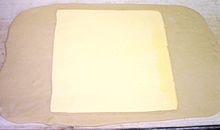Drawing fat
Drawing fat is butter or margarine with special processing properties, which is intended for the production of baked goods from drawing dough . In the production of these types of pastry, the drawing fat is worked into a base dough in layers by repeatedly folding and rolling out (the so-called touring ), so that the overall dough has a structure made up of very many extremely thin, alternating layers of fat and dough, which give these types of pastry their typical flaky texture Gives crumb . Drawing greases enable the production of a uniform, continuous layer structure through a suitable strength and plastic deformability and through the fact that they retain these properties over a relatively large temperature range . On the other hand, normal butter or baking margarine is used for the fat content in the base dough. Drawing fat is counted among the baking fats .
conditions
The need for special drawing fat results from the high mechanical stress on the fat in the production of drawing dough. For example, normal puff pastry is folded and rolled into a layer system with 144 fat layers just 60–70 µm thick per layer. Danish pastry and especially puff pastry, which contains neither yeast nor raising agents , rely on intensive physical dough loosening, which is made possible by the fact that the layers of fat retain the water vapor in the dough during baking . Only an intact layer system that is retained for a long time during baking ensures this loosening and leads to the characteristic layer structure of the crumb. The drawing fat must therefore roll out evenly, must not tear, smear or work into the dough or break through the dough. If possible, it must be as firm as the basic dough into which it is drawn.
Ordinary shortening does not fully meet these requirements: normal baking margarine is softer than desired, butter is also at room temperature, but it is too hard at lower temperatures. Suitable drawing grease, on the other hand, is solid but easily malleable and retains these properties at cool to warm room temperatures (approx. 18–24 ° C). So it has a flat melting curve . Like other shortening, it should melt completely at around body temperature so that the mouth feels pleasant.
Types of drawing fat
There are vegetable drawing fat (drawing margarine) as well as butter or pure butter (drawing butter, tour butter) intended for the production of drawing dough .
In the case of vegetable drawing fat, the plastic properties are influenced by the composition of the fat and the manufacturing process. The proportion of high-melting fats is relatively high. Using suitable manufacturing methods, a relatively large proportion of the fats crystallize during manufacture and not in the finished product, which improves plasticity. Changing the fat composition is problematic in the production of drawing butter. The proportion of high-melting fats can be increased, but such fractionated pure butter fat must not be advertised as “butter” to the customer, which means that butter loses an advantage over margarine. With unfractionated drawing butter (or pure fat drawing butter), the desired plastic properties are achieved through a suitable selection of raw materials and special manufacturing processes. Draw margarine also has a lower water content (around 10%) than other types of margarine. So that the fat does not smear or crumbly when it is rolled out, the margarine should be about the same temperature as the base dough during processing.
For processing, drawing fat must be formed into flat plates, placed on the dough and beaten. Because shaping destroys the crystal structure and thus makes the fat softer, preformed drawing fat plates are offered in the right size and thickness. These do not need to contain such a high proportion of high-melting fats as drawing fat in other forms. If the fat is formed into plates just before processing, flour can be used to act on it, especially when touring with an outer layer of fat (according to the so-called French method).
In some cases, products optimized for special types of baked goods are available, for example softer drawing fat for Danish pastry.
Individual evidence
- ↑ Udo Hanneforth: Production of fine baked goods . In: Wilfried Seibel (Ed.): Fine baked goods . 2nd Edition. Behr, Hamburg 2001, ISBN 3-86022-852-8 , pp. 138 ff .
- ↑ a b c d Claus Schünemann, Günter Treu: Technology of the bakery production. Specialized textbook for bakers . 10th edition. Gildebuchverlag, Alfeld / Leine 2009, ISBN 978-3-7734-0150-2 , p. 260 ff., 295 ff .
- ^ A b Hans-Gerhard Ludewig: recipe ingredients and their functional properties . In: Wilfried Seibel (Ed.): Fine baked goods . 2nd Edition. Behr, Hamburg 2001, ISBN 3-86022-852-8 , Backfette, p. 66 .
- ↑ Michael Bockisch: Dietary fats and oils . Ulmer, Stuttgart 1993, ISBN 3-8001-5817-5 , p. 616 f .
- ↑ Waldemar Ternes , Alfred Täufel, Lieselotte Tunger, Martin Zobel (eds.): Food Lexicon . 4th, comprehensively revised edition. Behr, Hamburg 2005, ISBN 3-89947-165-2 . , P. 2102
